The Economy of Catalonia
the_economy_of_catalonia._questions_and_answers_on_the_economic_impact_of_independence
the_economy_of_catalonia._questions_and_answers_on_the_economic_impact_of_independence
You also want an ePaper? Increase the reach of your titles
YUMPU automatically turns print PDFs into web optimized ePapers that Google loves.
first place, the exports <strong>of</strong> Catalan companies to the Spanish market would<br />
clearly be reduced. Secondly, a process <strong>of</strong> substituting imports from<br />
Spain could arise in <strong>Catalonia</strong> as a result <strong>of</strong> a counter-boycott <strong>of</strong> Spanish<br />
products. Indeed, it may well be imagined that the Catalans, faced with a<br />
political conflict like the one considered here, would show the same social<br />
reactions as the Spanish. Consequently, the most reasonable working<br />
hypothesis is that the boycott would be symmetrical. <strong>The</strong> boycott’s<br />
strictly commercial effects would have consequences for the economic<br />
activity and the generation <strong>of</strong> added value in <strong>Catalonia</strong> and such consequences<br />
should be quantified. In other words, the specific question to be<br />
answered is this: what would be the effect on the Catalan GDP <strong>of</strong> a politically<br />
motivated trade boycott carried out by some sectors <strong>of</strong> the Spanish<br />
market?<br />
Essentially, what the aforementioned book does is to compare two situations<br />
<strong>of</strong> the Catalan economy in 2005. 55 <strong>The</strong>se two situations are, on the<br />
one hand, the real Catalan economy, as described in the <strong>of</strong>ficial statistics<br />
and specifically in the input-output table and, on the other hand, a simulated<br />
Catalan economy which takes into account the economic effects<br />
derived from the changes produced by a hypothetical independence.<br />
<strong>The</strong>se changes, as stated earlier, centre on the reduction <strong>of</strong> Catalan exports<br />
to Spain (thus reducing production, added value and jobs) and on<br />
the substitution <strong>of</strong> imports from Spain (entailing contributions in the opposite<br />
direction)..<br />
One obvious difficulty when presenting the results <strong>of</strong> this analysis is that<br />
it is impossible to determine, even approximately, the effective extent <strong>of</strong><br />
such a boycott, that is to say, the specific reduction in exports to Spain.<br />
In the book “Sense Espanya” we describe the available evidence on<br />
which the determination <strong>of</strong> this variable could be based, taking into account<br />
existing opinion polls, comparative experiences at an international<br />
level and the Spanish boycott episode <strong>of</strong> 2005, but it remains impossible<br />
to establish unequivocally the real extent <strong>of</strong> a possible boycott. For this<br />
reason we present the results <strong>of</strong> our simulation with its full range <strong>of</strong> possibilities,<br />
including all possible scenarios, under the hypothesis that the<br />
55. All the details <strong>of</strong> the calculation method can be found in the article by Cuadras<br />
Morató and Guinjoan entitled ”Una approximació a l’impacte sobre el VAB català de la<br />
reducció dels fluxos comercials entre Catalunya i la resta d’Espanya” (An approximation<br />
to the impact on the Catalan GVA <strong>of</strong> the reduction <strong>of</strong> trade flows between <strong>Catalonia</strong><br />
and the rest <strong>of</strong> Spain), Revista Econòmica de Catalunya 2012).<br />
Independence and boycott 185


